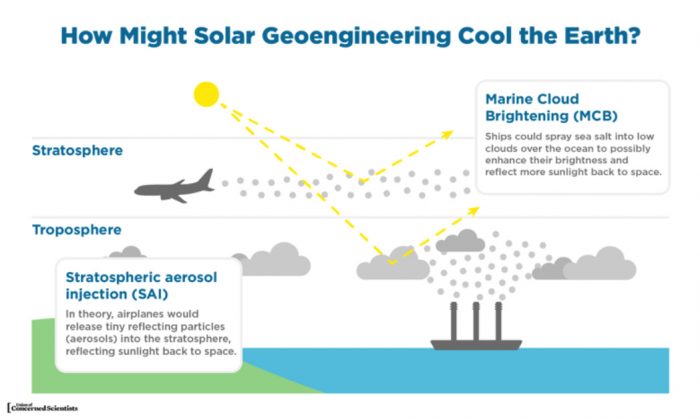When it comes to combating climate change, some experts, frustrated with the lack of tangible progress toward greenhouse gas (GHG) emission reductions, are urging us to start placing our faith in technological innovations rather than universal enlightenment.
The technological innovation they speak of is rather radical. It involves giving Mother Earth an intervention – a huge one – by completely modifying the globe’s atmospheric conditions.
With a flick of the switch, the global thermostat is turned off.
Now how does this major revamp work?
Reconditioning Earth’s climate.
Solar geoengineering involves blocking 1 – 2% of the sunlight that reaches Earth with some sort of “buffer”.
Scientists carry out climate modelling, made possible by high-performance computing (HPC), to simulate a mind-boggling plethora of climate scenarios, which they use to formulate different approaches and determine if they will work.
Perhaps the most widely circulated technique is injecting tiny reflecting particulate matter, or aerosols, into the Earth’s upper atmosphere using airplanes through a process called stratospheric aerosol injection (SAI).
The particulate material, released into the stratosphere where they surround much of the Earth, reflects heat from the sun back into space, cooling the planet.
This idea stemmed from research showing that parts of the globe became cooler after ash from volcanic eruptions engulfed the atmosphere. In 1991 when Mount Pinatubo erupted, 20 million tonnes of sulphur dioxide were ejected into the atmosphere, causing a global temperature drop of half a degree Celsius from 1991 to 1993.
Another popular method – marine cloud brightening (MCB) – uses sea salt to stimulate cloud formation over oceans, which is a more regional solution to reflect sunlight.
In this approach, ships would spray sea salt into low-lying marine clouds in the troposphere to enhance their brightness and reflectivity, resulting in increased regional-scale cooling. However, this is not to be confused with cloud seeding, which adds chemicals to clouds to increase rainfall.

A pictorial description of how SAI and MCB work to reduce global temperatures by shielding sun rays. Photo credit: UCSUSA.org
Is this really a good idea?
Climate researchers have been assessing the risks and benefits of this form of climate intervention through computer modeling with advanced supercomputers, as well as observational studies.
Critics of this climate strategy say that it will do nothing to curb the buildup of greenhouse gases in our atmosphere, as it does not address the root cause of climate change: emissions of heat-trapping gases, mostly from the burning of fossil fuels.
It would not reverse ocean acidification or lessen the detrimental effects on public health and the environment from widespread fossil fuel usage.
Deploying such a technology would also run the risk of it becoming a convenient excuse to dampen the urgency of emission reduction, and delay the progress towards a low-carbon economy.
However, it could act as an extremely useful temporary measure to lower Earth’s temperature, buying humanity some precious time to execute extensive decarbonisation efforts and subsequently to adapt. This strategy is advocated by many proponents of geoengineering.
A study has shown that “small doses” of geoengineering are helpful to reduce the most dangerous aspects of global warming while simultaneous decarbonisation is being done on land.
The researchers also warned that if GHG emissions from burning coal, oil and natural gas continue unabated, geoengineering will still be a futile effort to limit warming.
At dangerous levels, GHG would have a negative impact on stratocumulus clouds, making them thin, and even eliminating them. Without this crucial cloud cover, the introduction of sun-shielding aerosols into the atmosphere will basically be of little to no avail.
Potential as an emergency backup plan?
An ingenious solution, or a desperate attempt?
Not yet tested in the real world, the theory of geoengineering continues to be a highly debated topic in climate talks.
While researchers continue to investigate the potential feasibility and efficacy of geoengineering techniques, it might be more sensible to maintain climate mitigation and human adaptation as the top priorities to fight climate change effectively.
As the old saying goes: prevention is better than cure.






























